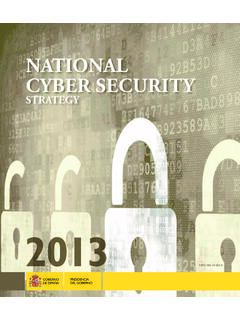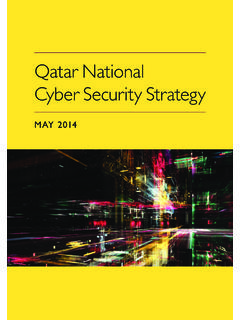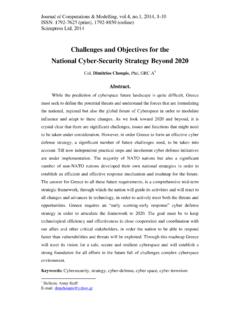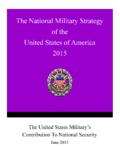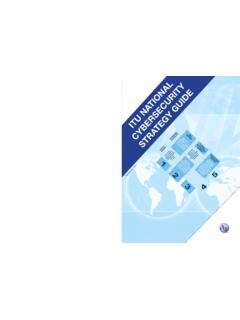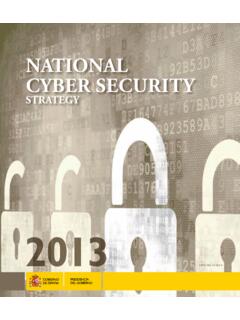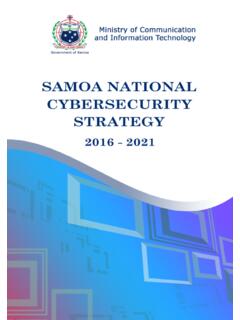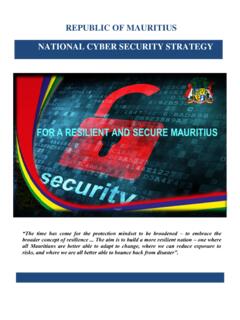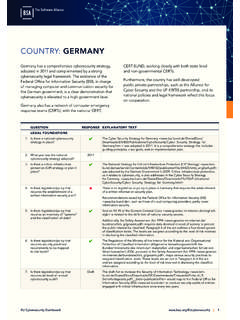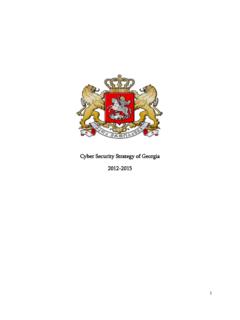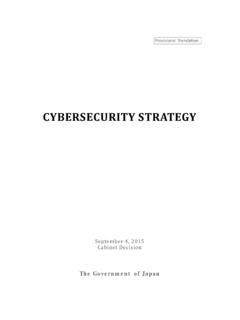Transcription of Cyber Security Strategy - ENISA
1 2014 2017 Ministry of Economic Affairs and Communication 2014 Cyber Security Strategy 1 TABLE OF CONTENTS Introduction .. 2 1. Analysis of current situation .. 2 Sectoral progress .. 2 Trends .. 4 Challenges .. 6 2. Principles of ensuring Cyber 7 3. General objective of the Strategy for 2017 .. 7 4. Subgoals .. 8 5. Parties related to the Strategy .. 13 2 INTRODUCTION The Cyber Security Strategy 2014-2017 is the basic document for planning Estonia s Cyber Security and a part of Estonia s broader Security Strategy . The Strategy highlights important recent developments, assesses threats to Estonia s Cyber Security and presents measures to manage threats.
2 This Strategy continues the implementation of many of the goals found in the Cyber Security Strategy 2008-2013; however, new threats and needs which were not covered by the previous Strategy have also been added. 1. ANALYSIS OF CURRENT SITUATION Sectoral progress In 2009, a Cyber Security Council was added to the Security Committee of the Government of the Republic, whose main task is to support strategic level inter-agency co-operation and oversee the implementation of Cyber Security Strategy objectives. In 2010, by a decision of the Government of the Republic, the Estonian Informatics Centre was given government agency status.
3 The renamed Estonian Information System Authority (Riigi Infos steemi Amet hereinafter RIA) received additional powers and resources for organising protection of the state s information and communication technology (hereinafter ICT) infrastructure, and exercising supervision over the Security of information systems. For the purposes of organising the protection of infrastructure, the Department of Critical Information Infrastructure Protection (hereinafter CIIP) was formed within the RIA. In early 2010, the RIA launched the critical information infrastructure (hereinafter CII) mapping project, which identified the dependencies of vital services on information systems.
4 On the basis of the mapping, Security requirements for vital information systems necessary for the functioning of the state were developed. In 2011, a CIIP commission was formed to promote public-private cooperation. The purpose of the commission, which brings together Cyber Security and IT managers from vital services agencies, is to exchange operational information, identify problems and make suggestions for improving the Cyber Security of the country's critical infrastructure. 3 In 2012, the cybercrime investigation capabilities of the Police and Border Guard Board (hereinafter PBGB) were consolidated into a single department.
5 In addition, officials dealing with cybercrime and digital evidence management procedures from various units in the prefectures were consolidated into cybercrime and digital evidence services that were established in prefectures in 2013. The PBGB is also engaged in raising awareness regarding Cyber threats, which, among other things, has resulted in the creation of the positions for web-constables. A web-constable is tasked with raising people's awareness about the Security of the Internet and protecting children and young people online. The Estonian Internal Security Service strengthened its investigative capabilities in order to prevent threats to national Security , including Cyber attacks and espionage.
6 The creation of the Estonian Defence League s Cyber Unit (hereinafter EDL CU), which took place as a result of collaboration between the public, private and third-sector, has been instrumental in ensuring national defence. The expertise of EDL CU volunteers is applied to improve the Security of Estonian state agencies and companies information systems through coordinated exercises, testing of solutions, training, The EDL CU can also be engaged to support civilian institutions and protect critical infrastructure in a crisis situation. Domestic and international Cyber Security training exercises have also played an important role in the development and assessment of Cyber Security capabilities.
7 The Government of the Republic s Cyber defence headquarters exercise Cyber Fever" and NATO Crisis Management Exercise CMX 2012 took place in 2012. Each year, the NATO Cooperative Cyber Defence Centre of Excellence (NATO CCD COE) exercise Locked Shields takes place in Estonia. Since 2013, the NATO Cyber defence exercise Cyber Coalition has also been hosted in Estonia. The Defence Forces has also created a Cyber Range to support Cyber defence related training. The Range is used to carry out the aforementioned Cyber exercises, organise domestic exercises and in the instruction provided by universities. In the field of Cyber Security , the main provider of training and awareness-raising is the Information Technology Foundation for Education (hereinafter HITSA), formerly known as the Tiger Leap Foundation.
8 HITSA training is offered to pre-schoolers well as older children, while also involving parents and teachers in the process. A state-private partnership project was launched in 2013 to raise the skills and Security awareness of smart device users, developers and vendors. In cooperation between Tallinn University of Technology (TUT) and 4 the University of Tartu, the international Master s programme in Cyber Security was opened in 2009, with 50 students accepted into the programme each year. In 2014, TUT, in cooperation with the Estonian Centre 2 CENTRE, opened a Master s programme in Digital Forensics. Estonia s 2 CENTRE Cybercrime Centre of Excellence is part of the European Union s network of 2 CENTRE competency centres, where professionals are trained in the fight against cybercrime, and continuation training is arranged for them.
9 Estonia has successfully cooperated with other ICT-advanced countries and international organizations in the field of Cyber Security . An active role in shaping Cyber Security policy led to the establishment of the NATO Cooperative Cyber Defence Centre of Excellence in Estonia. Estonia has contributed to Cyber Security becoming part of NATO and European Union policy, and other countries interest towards Estonia s experience in Cyber Security has grown significantly. Cyber Security related cooperation has been successful on the regional level between the Nordic countries and the Baltic States, as well as with other strategic partners and like-minded countries.
10 Estonia is also participating in newer forms of cooperation - the Freedom Online Coalition, the United Nations Group of Governmental Experts, the OSCE informal working group on developing confidence building measures in cyberspace, Friends of the Presidency of the European Union, and others. Trends The continued rapid development of information and communication technologies, globalization, the drastic increase in data volumes and the growing number of different types of equipment connected to data networks have an impact on daily life, the economy and the functioning of the state. On the one hand, this level of ICT development will contribute to the improved availability and usability of services, enhance transparency and citizen participation in governance, and cut public as well as private sector costs.
